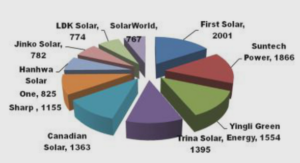Mémoire online thermoplastic Natural Rubbers based on Natural Rubber (NR) and Ethylene Vinyl Acetate Copolymer (EVA), with Natural Rubber-graft-Poly, tutoriel & rapport PDF.
CHAPTER 1: INTRODUCTION
Background
Thermoplastic elastomers (TPEs) play an important role in the polymer industry due to their good processability and their elastomeric properties (Ibrahim and Dahlan, 1998). There has been a growth of subcategories of TPEs to distinguish between different types of materials. Several examples are block copolymers, thermoplastic rubber blends, and ionomers. However, extensive studies have been carried out in the area of TPEs based on elastomer/thermoplastic blends (Abdou-Sabet and Patel, 1991). This is due to blending technology is less expensive than the synthesis of new polymer or copolymer, including development of monomer preparation and polymerization technology. TPEs based on NR/thermoplastic blends are called “thermoplastic natural rubber” (TPNR) blends. This type of blend has grown along two distinctly different product classes. That is, simple blend based on blending of natural rubber with polyolefin that is commonly designated as thermoplastic elastomeric olefins (TEOs) or thermoplastic polyolefins (TPOs), and another class is thermoplastic vulcanizates (TPVs) or dynamic vulcanizates (DVs). The dynamically vulcanized thermoplastic elastomer blends have attracted more interest than the simple blend because of their important technical advantages in processing of the dynamic vulcanization from the peculiar morphological features, and because they tolerate elevated temperature (Mousa et al., 1998; Wang et al., 2002; Nakason et al., 2006). Furthermore, it has been wellestablished that the dynamic vulcanization of the rubber causes the improvement of its mechanical, thermal, and impact properties by comparison with the uncured or partially crosslinked composition (Kim et al., 1996, Gosh et al., 1996; Mousa et al., 1998; Hailongjin et al., 2002; Wang et al., 2002). A great number of known thermoplastics were used to prepare TPNRs based on blending of NR. The most consideration were polystyrene (PS) (Asaletha et al., 1999), polypropylene (PP) (Suryadiansyah, 2002; Varghese et al., 2004; Ismail; Nakason et al., 2006), high density polyethylene (HDPE) (Nakason et al., 2006a), linear low density polyethylene (LLDPE) (Abdullah et al., 1995; Dahlan et al., 2000), poly(methyl methacrylate) (PMMA) (Oommen and Thomas, 1996; Mina et al., 2004), and polyamide 6 (PA-6)( Carone et al., 2000). Among the various types of thermoplastics, EVA is one of the interested materials because of some superior properties including excellent ozone resistance, weather resistance, thermal resistance (Jansen and Soares, 1996; Koshy et al., 1992; Chowdhury et al., 2000; Jansen et al., 1996), mechanical behavior (Doak, 1986; Mohamad et al., 2006; Varghese, 1995), and halogen-free thermoplasticity. Also, NR provides to the blend high elasticity and resistance to impact (Derouet et al., 2007; Asaletha et al., 1999).
Melt blending of elastomers and thermoplastics leads normally to immiscible blends due to the difference between intrinsic properties of the blend components.
This causes the formation of TPV materials that are characterized by two-phase morphologies with high interfacial tension, poor interface adhesion, and poor mechanical properties, which limits the usage of the materials. The compatibility of the rubber-thermoplastic blends has been improved by means of blend compatibilizers. To obtain blends with convenient properties, one accessible route consists to incorporate a graft copolymer as blend compatibilizer.
………..





